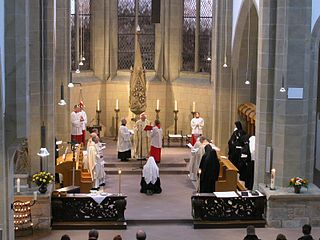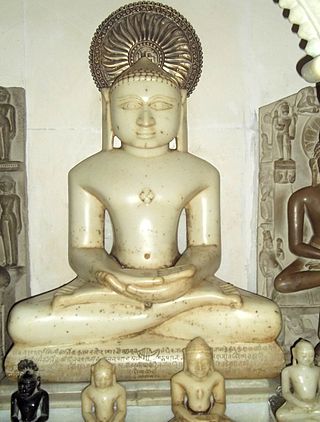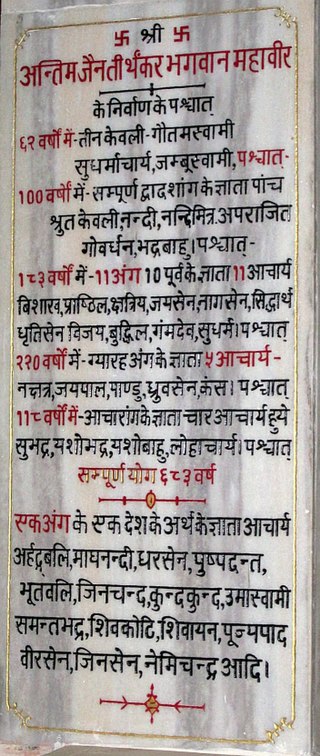
Jainism, also known as Jain Dharma, is an Indian religion. Jainism traces its spiritual ideas and history through the succession of twenty-four tirthankaras, with the first in the current time cycle being Rishabhadeva, whom the tradition holds to have lived millions of years ago, the twenty-third tirthankara Parshvanatha, whom historians date to the 9th century BCE, and the twenty-fourth tirthankara Mahavira, around 600 BCE. Jainism is considered to be an eternal dharma with the tirthankaras guiding every time cycle of the cosmology. The three main pillars of Jainism are ahiṃsā (non-violence), anekāntavāda (non-absolutism), and aparigraha (asceticism).

Mahavira also known as Vardhaman, was the 24th tirthankara of Jainism. He was the spiritual successor of the 23rd tirthankara Parshvanatha. Mahavira was born in the early part of the 6th century BCE into a royal Kshatriya Jain family in ancient India. His mother's name was Trishala and his father's name was Siddhartha. They were lay devotees of Parshvanatha. Mahavira abandoned all worldly possessions at the age of about 30 and left home in pursuit of spiritual awakening, becoming an ascetic. Mahavira practiced intense meditation and severe austerities for twelve and a half years, after which he attained Kevala Jnana (omniscience). He preached for 30 years and attained Moksha (liberation) in the 6th century BCE, although the year varies by sect.

Bimbisāra or Shrenika and Seniya in the Jain histories was a King of Magadha and belonged to the Haryanka dynasty. He was the son of Bhattiya. His expansion of the kingdom, especially his annexation of the kingdom of Anga to the east, is considered to have laid the foundations for the later expansion of the Mauryan Empire.

Religious vows are the public vows made by the members of religious communities pertaining to their conduct, practices, and views.

Jinasena was a monk and scholar in the Digambara tradition of Jainism. He was patronized by the Rashtrakuta king Amoghavarsha I. He was the author of Adipurana and Mahapurana.

Jainism has had a notable following in Gujarat. According to the 2011 Census of India, around 0.959% of the population of Gujarat is Jain. There are several old Jain temples that draw pilgrims from Jains around the world in places such as Palitana, Taranga, Sankheshwar, Idar.
Jain cosmology is the description of the shape and functioning of the Universe (loka) and its constituents according to Jainism. Jain cosmology considers the universe as an uncreated entity that has existed since infinity with neither beginning nor end. Jain texts describe the shape of the universe as similar to a man standing with legs apart and arms resting on his waist. This Universe, according to Jainism, is broad at the top, narrow at the middle and once again becomes broad at the bottom.

Neminatha, also known as Nemi and Arishtanemi, is the twenty-second tirthankara (ford-maker) in Jainism. Along with Mahavira, Parshvanatha and Rishabhanatha, Neminatha is one of the twenty four tirthankaras who attract the most devotional worship among the Jains.
The Solar dynasty or the Ikshvaku dynasty was founded by the legendary king Ikshvaku. The dynasty is also known as Sūryavaṃśa which means that this dynasty prays to the Sun as their God and their originator, and along with Lunar dynasty comprises one of the main lineages of the Kshatriya Varna.
Siddhasēna Divākara was a jain monk in the fifth century CE who wrote works on Jain philosophy and epistemology. He was like the illuminator of the Jain order and therefore came to be known as Divākara, "Sun". He is credited with the authorship of many books, most of which are not available. Sanmatitarka is the first major Jain work on logic written in Sanskrit.
Jainism is a religion founded in ancient India. Jains trace their history through twenty-four tirthankara and revere Rishabhanatha as the first tirthankara. Some artifacts found in the Indus Valley civilization have been suggested as a link to ancient Jain culture, but very little is known about the Indus Valley iconography and script. The last two tirthankara, the 23rd tirthankara Parshvanatha and the 24th tirthankara Mahavira are considered historical figures. Mahavira was a contemporary of the Buddha. According to Jain texts, the 22nd Tirthankara Neminatha lived about 85,000 years ago and was the cousin of Krishna.

A Pattavali, Sthaviravali or Theravali, is a record of a spiritual lineage of heads of monastic orders. They are thus spiritual genealogies. It is generally presumed that two successive names are teacher and pupil. The term is applicable for all Indian religions, but is generally used for Jain monastic orders.
Kevala gyana or Keval gyan means omniscience in Jainism and is roughly translated as complete understanding or supreme wisdom.

Gautam Swami was the Ganadhara of Mahavira, the 24th and last Jain Tirthankara of present half cycle of time. He is also referred to as Indrabhuti Gautam, Guru Gautam, Gautam Swami Ganadhara and Gautam Swami.
According to the Jain cosmology, the śalākapuruṣa "illustrious or worthy persons" are 63 illustrious beings who appear during each half-time cycle. They are also known as the triṣaṣṭiśalākāpuruṣa. The Jain universal or legendary history is a compilation of the deeds of these illustrious persons. Their life stories are said to be most inspiring.

Chandraprabha is the eighth Tirthankara of Avasarpini. Chandraprabhu was born to King Mahasena and Queen Lakshmana Devi at Chandrapuri to the Ikshvaku dynasty. According to Jain texts, his birth-date was the twelfth day of the Posh Krishna month of the Indian calendar. He is said to have become a siddha, i.e. soul at its purest form or a liberated soul.

Kunthunath was the seventeenth Tirthankara, sixth Chakravartin and twelfth Kamadeva of the present half time cycle, Avasarpini. According to Jain beliefs, he became a siddha, liberated soul which has destroyed all of its karma. Kunthunatha was born to King Surya (Sura) and Queen Shridevi at Hastinapur in the Ikshvaku dynasty on the fourteenth day of the Vaishakh Krishna month of the Indian calendar.

Bharata was the first chakravartin of avasarpini. He was the eldest son of Rishabhanatha, the first tirthankara. He had two sons from his chief-queen Subhadra named Arkakirti and Marichi. He is said to have conquered all the six parts of the world and to have engaged in a fight with Bahubali, his brother, to conquer the last remaining city The ancient name of India was named "Bhāratavarsha" or "Bhārata" or "Bharata-bhumi" after him.

Udayin also known as Udayabhadra was a king of Magadha in ancient India. According to the Buddhist and Jain accounts, he was the son and successor of the Haryanka king Ajatashatru. Udayin laid the foundation of the city of Pataliputra at the confluence of two rivers, the Son and the Ganges. He shifted his capital from Rajgriha to Patliputra due to the latter's central location in the empire.

Sagara is a king of the Suryavamsha dynasty in Hinduism. The son of Bahuka, he ruled the city of Ayodhya, with two wives, and 60,001 sons.














